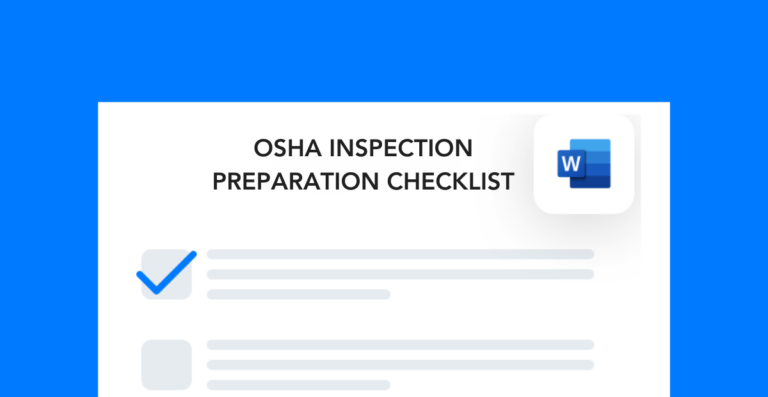No employer wants to hear that an OSHA Inspector is at their front door, likely looking into potential OSHA infractions. While there are many different reasons why an inspector may visit a workplace, what they’re looking for never changes.
OSHA publishes a list of top violations every year, and its website even allows you to discover the top issues in your industry. In this post, I’ll walk you through the top three most common OSHA infractions and give you a few ways to avoid infractions identified by OSHA.
Free checklist!
Use this simple checklist to ensure you’re ready for the next inspection. Proper use of this checklist helps you avoid common OSHA infractions.
Fall protection OSHA infractions
In the construction industry, employers with workers performing tasks at 6 feet or higher fall under OSHA’s fall protection standard. In the general industry category, this height minimum is 4 feet.
Here are two of the major fall protection requirements you must meet:
Written fall protection program: To avoid a citation for this, I’d recommend having a qualified “competent person” to write out your site’s program (or at least advise you in the development process).
Compliant fall protection equipment: Implement an equipment inspection process that ensures your harnesses are in good condition. You’ll also want to take a regular equipment inventory to make sure you have enough to go around and fulfill OSHA’s standards on infractions.
Hazard communication violations
The hazard communication standard relates to hazardous chemicals in the workplace. There are many ways for an employer to be out of compliance with these standards.
One of the more common ways is to have a general hazard communication plan that is not specific to your business. If your plan does not go into detail about the chemicals used in your workplace, then you will not be compliant.
To achieve compliance, list out where you store each of the hazardous chemicals in your operations. Additionally, make sure you include the locations of all your safety data sheets (SDS). For more guidance on implementing a compliant SDS process, check out our full guide here. This will help you in preventing common OSHA infractions regarding hazards.
Another major component of HazCom compliance is ensuring that all your workers have training. Any workers who use, or could potentially be exposed to, hazardous chemicals must have appropriate training. Employers are often cited because they are not able to provide proof of standard-compliant training.
My biggest recommendation here is to document everything. This means recording:
- Create a record of all training classes onsite, including who attended, to avoid OSHA citation risks and infractions.
- Keep a record of all past-due training and the reason for delinquency.
- Scheduling and tracking HazCom refresher courses.
Respiratory protection OSHA infractions
This standard, like fall protection and hazard communication, is multi-faceted. There are many things that could cause an employer to get cited for respiratory protection. You must complete hazard assessments if you’re going to expose employees to respiratory hazards.
If a hazard assessment determines that your employees need respiratory protection, then you need to have a written respiratory protection plan. Employees who wear respirators must be medically cleared to do so by a licensed healthcare provider and have an annual fit test. These steps are crucial in preventing infractions observed by OSHA in respiratory standards.
Major takeaways about osha infractions
One of the biggest ways to protect your company from OSHA citations is to document what you’re doing. The quality of your recordkeeping may determine whether you receive a warning or a fine.
At the very least, you should want thorough records for internal investigations and inspections. And this requires you to have a standard reporting process in place.
EHS software is a great tool for implementing standard recordkeeping and management of change systems. If your team struggles to keep track of audits, inspections, training logs, and other compliance documents, you should examine your approach and consider switching to an automated system to avoid possible infractions and citations from OSHA.




